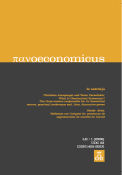Macroeconomic Effects of Unconventional Balance Sheet Policies in the United States and the Euro Area
DOI:
https://doi.org/10.2298/PAN170910023RKeywords:
Unconventional monetary policy, Quantitative easing, Transmission mechanism, Uncertainty and growth, Central bank’s money creationAbstract
Post Great Recession vector autoregression analysis revealed that the reserves’ creation of the European Central Bank (ECB) until 2015 had an impact on the perceived credit risk that was either statistically insignificant or opposite to the expected one. The ECB’s unconventional measures returned the real GDP growth merely to an equilibrium of nil growth. In the United States, unconventional balance sheet policies of the Federal Reserve System (the Fed) significantly increased the real GDP by between 3.2% and 5.3% and reduced the initial rise of the perceived credit risk. We argue that the plausible reason for the discrepancy between the Fed and the ECB’s outcomes were the contrasting goals of both central banks. The major conclusion is that creation of money by the central bank may support the economy after a crisis, but it cannot deliver long-run prosperity. The positive effects of balance sheet policies were found to be short-lasting.
Key words: Unconventional monetary policy, Quantitative easing, Transmission mechanism, Uncertainty and growth, Central bank’s money creation.
JEL: E31, E40, E58






